1997 CADILLAC SEVILLE brake
[x] Cancel search: brakePage 11 of 370
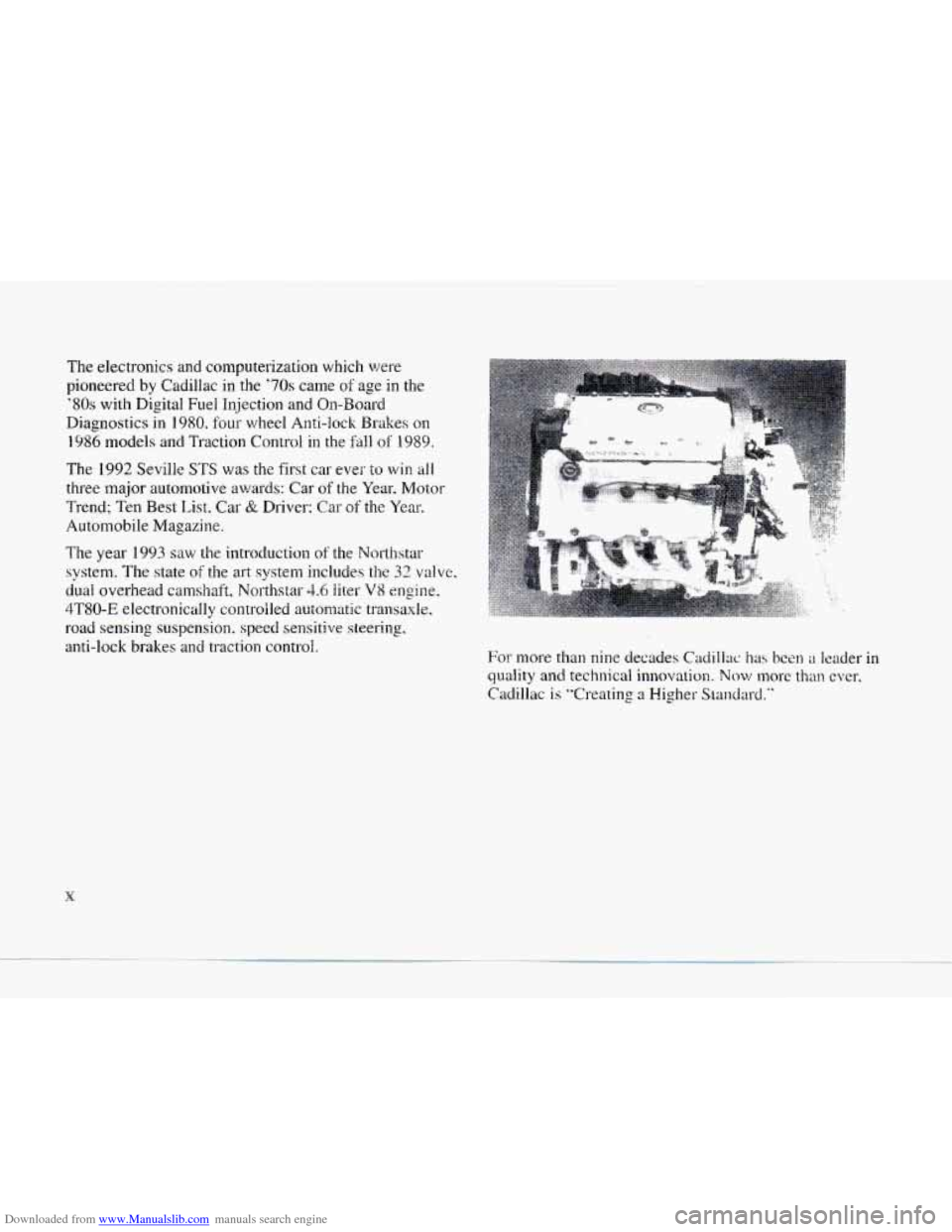
Downloaded from www.Manualslib.com manuals search engine The electronics and computerization which were
pioneered
by Cadillac in the '70s came of age in the
'80s with Digital Fuel Injection and On-Board
Diagnostics
in 1980, four wheel Anti-lock Brakes on
I486 models and Traction Control in the fdl of 1989.
The 1992 SevilIe S'TS was the first car ever to win all
three major automotive awards: Car of the Year. Motor
Trend; Ten Best I..& Car & Driver; Car of the Yeac
Automobile Magazine.
The year I993 saw the introduction of the Northstar.
system. The state
of the art system includes the 32 valve.
dual overhead camshaft, Northstar 4.6 liter VX engine.
47'80-E electronically controlled automatic transaxle.
road sensing suspension.
speed sensitive steering,
anti-lock brakes and traction control.
For inore than nine decades Cadillac has been a leader in
quality
and technical innovation. Now nlorc than ever.
Cadillac is
"Creating a Higher- Standard."
*-
x
Page 14 of 370
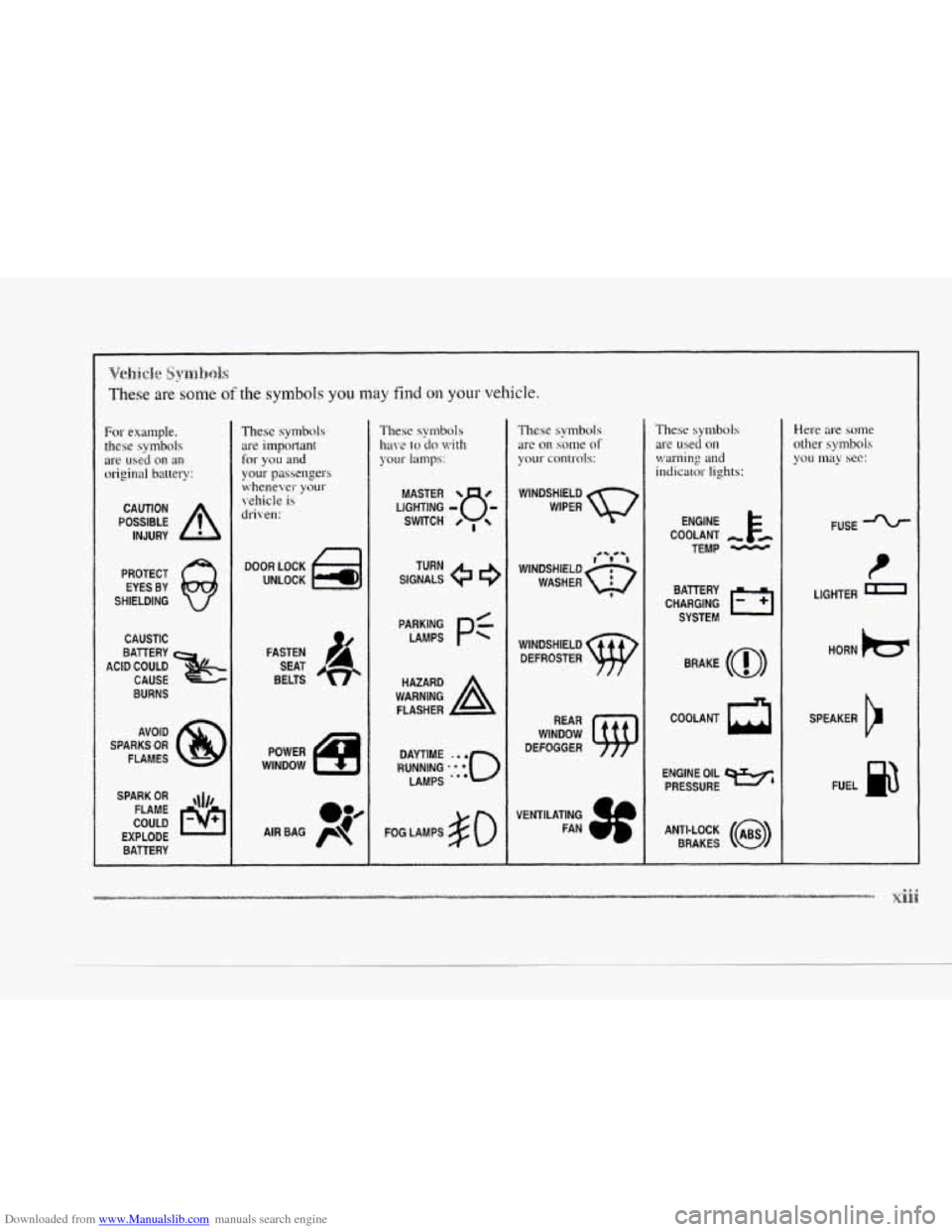
Downloaded from www.Manualslib.com manuals search engine c
c
c
c
c
VeSnicle Synb&
These are some of the symbols you may find 011 your vehicle.
For example.
these symbols
are used on
an
original battery:
POSSIBLE A
CAUTION
INJURY
PROTECT EYES
BY
SHIELDING
CAUSTIC
ACID COULD
x
BATTERY
CAUSE
BURNS
SPARK
OR ,\I/,
COULD FLAME
EXPLODE BATTERY
These symbols
arc
important
for you and
your passengers
u:henever your
\.chicle is
driven:
n
DOOR LOCK
UNLOCK
FASTEN BELTS SEAT
.;$-
e;/
AIR
BAG f!! FOG
LAMPS # 0
These symbols
are
on some of
your controls:
WINDSHIELD
WIPER
WINDSHIELD
DEFROSTER
VENTILATING FAN
These symbols
are used on
warning and
indicator lights:
COOLANT -
TEMP -
BRAKE (0)
COOLANT
a
ENGINE OIL w,
PRESSURE
ANTI-LOCK
(@)
BRAKES
Here are some
other symbols
you may see:
FUSE -%-
t
LIGHTER m
HORN kz7
SPEAKER
b
FUEL p3
Page 62 of 370
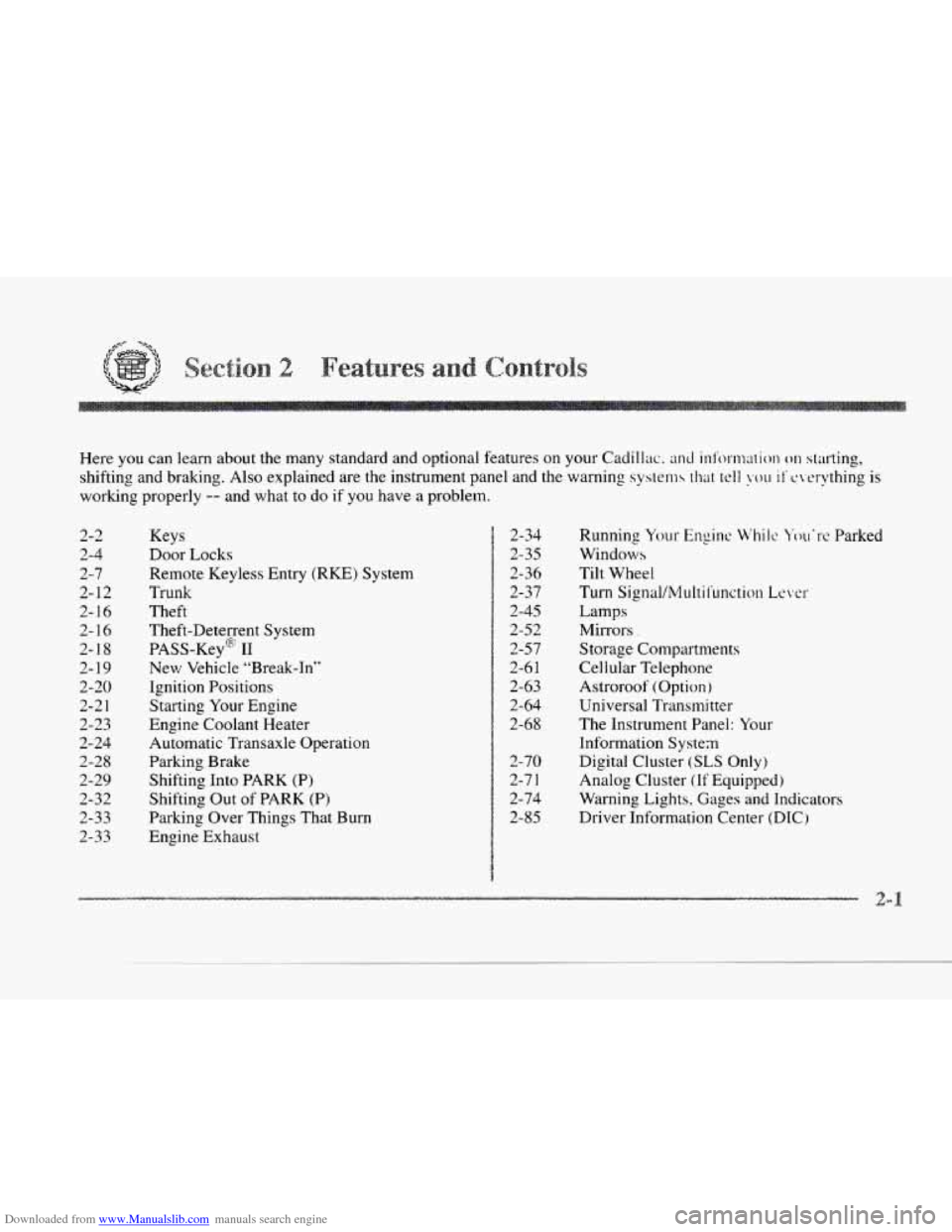
Downloaded from www.Manualslib.com manuals search engine c
c
c
c
2-2
2-4
2-7
2-12
2- 16
I 7-16
2-18
2- 19
2-20
2-2
1
2-23
2-24
2-28
2-29
2-32
2-33
2-33 Here
you can learn about the many standard and optional features on your Cadillac. mcl inf’ol-mation 011 starting,
shifting and braking. Also explained are
the instrument panel and the warning systems that tell y~ i 1‘ c\wything is
working properly -- and what to do if you have a problem.
Keys
Door Locks
Remote Keyless Entry (RKE) System
Trunk
Theft
Theft-Deterrent System
PASS-Key@
I1
New Vehicle “Break-In’’
Ignition Positions
Starting Your Engine
Engine Coolant Heater
Automatic Transaxle Operation
Parking Brake
Shifting Into PARK (P)
Shifting Out of
PARK (P)
Parking Over Things That Burn
Engine Exhaust 2-34
2-35
2-36
2-37
2-45
2-52
2-57
2-6
I
2-63
2-64
2-68
Running
Your Engine Whilc \’OLI.I-C Parked
Windows
Tilt Wheel
Turn Sigl.lal/MultitLInction
Le~tel-
Lamps
Mirrors
.
Storage Compartments
Cellular Telephone
Astroroof (Option)
Universal Transmitter
The Instrument Panel: Your
Information System
2-70 Digital Cluster
(SLS Only)
2-7
1 Analog Cluster (If Equipped)
2-74 Warning Lights. Gages and Indicators
2-85 Driver Information Center (DIC
j
Page 63 of 370
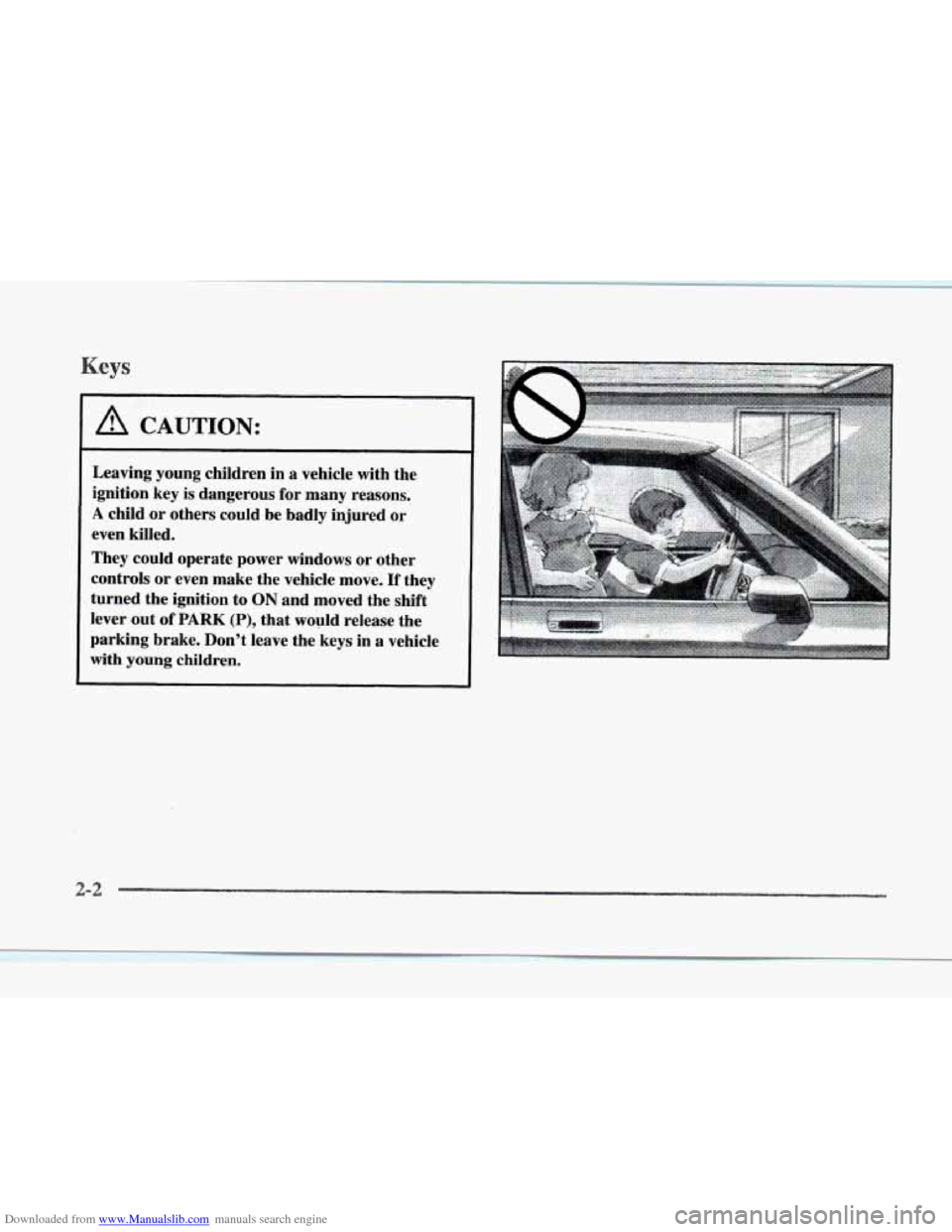
Downloaded from www.Manualslib.com manuals search engine A CAUTION:
Leaving young children in a vehicle with the
ignition key is dangerous for many reasons.
A child or others could be badly injured or
even killed,
They could operate power windows or other
controls
or even make the vehicle move. If they
turned the ignition
to ON and moved the shift
lever out of
PARK (P), that would release the
parking brake. Don’t leave the keys
in a vehicle
with young children.
:.: ..... --
Page 80 of 370
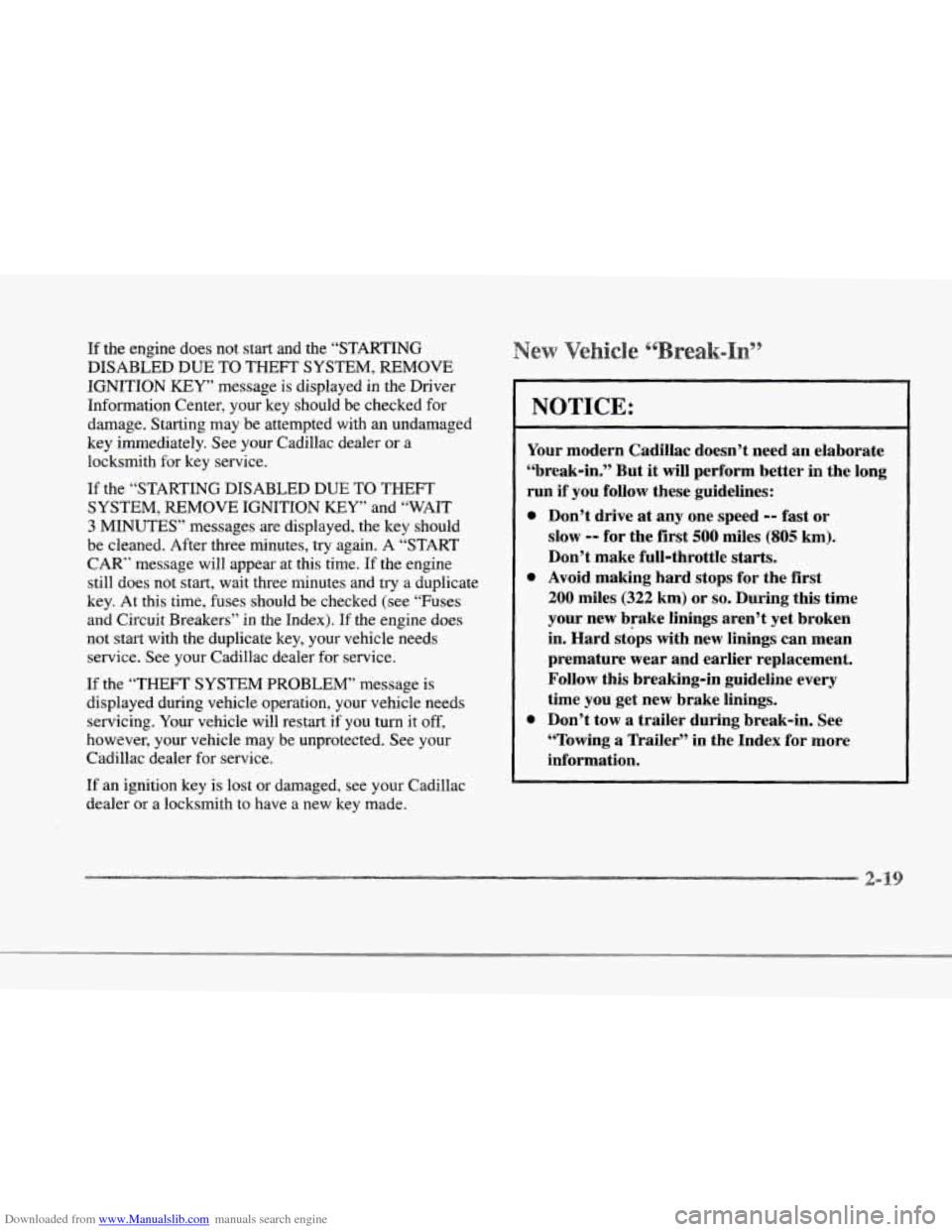
Downloaded from www.Manualslib.com manuals search engine r
r
r
r
r
r
r
r
If the engine does not start and the “STARTING
DISABLED DUE TO THEFT SYSTEM, REMOVE
IGNITION
KEY” message is displayed in the Driver
Information Center, your key should be checked for
damage. Starting may be attempted with an undamaged
key immediately. See your Cadillac dealer or a
locksmith
fur key service.
If the “STARTING DISABLED DUE TO THEFT
SYSTEM,
REMOVE IGNITION KEY” and “WAIT
3 MINUTES” messages are displayed, the key should
be cleaned. After three minutes,
try again. A “START
CAR” message will appear
at this time. If the engine
still does not start, wait three minutes and try a duplicate
key. At this time, fuses should be checked (see “Fuses
and Circuit Breakers” in the Index). If the engine does
not start with the duplicate key, your vehicle needs
service. See your Cadillac dealer for service.
If the “THEFT SYSTEM PROBLEM’ message is
displayed during vehicle operation, your vehicle needs
servicing. Your vehicle will restart if you turn it
off,
however, your vehicle may be unprotected. See your
Cadillac dealer for service.
If an ignition key is lost or damaged, see your Cadillac
dealer or a locksmith to have a new key made.
e c6
NOTICE:
Your modern Cadillac doesn’t need an elaborate
“break-in.” But it
will perform better in the long
run if you follow these guidelines:
0 Don’t drive at any one speed -- fast or
slow -9 for the first 500 miles (805 km).
Don’t make full-throttle starts.
200 miles (322 km) or so. During this time
your new brake linings aren’t yet broken
in. Hard stops with new linings can mean
premature wear and earlier replacement.
Follow this breaking-in guideline every
time you get new brake linings.
0 Don’t tow a trailer during break-in. See
“Towing a Trailer” in the Index for more
information.
0 Avoid making hard stops for the first
Page 86 of 370
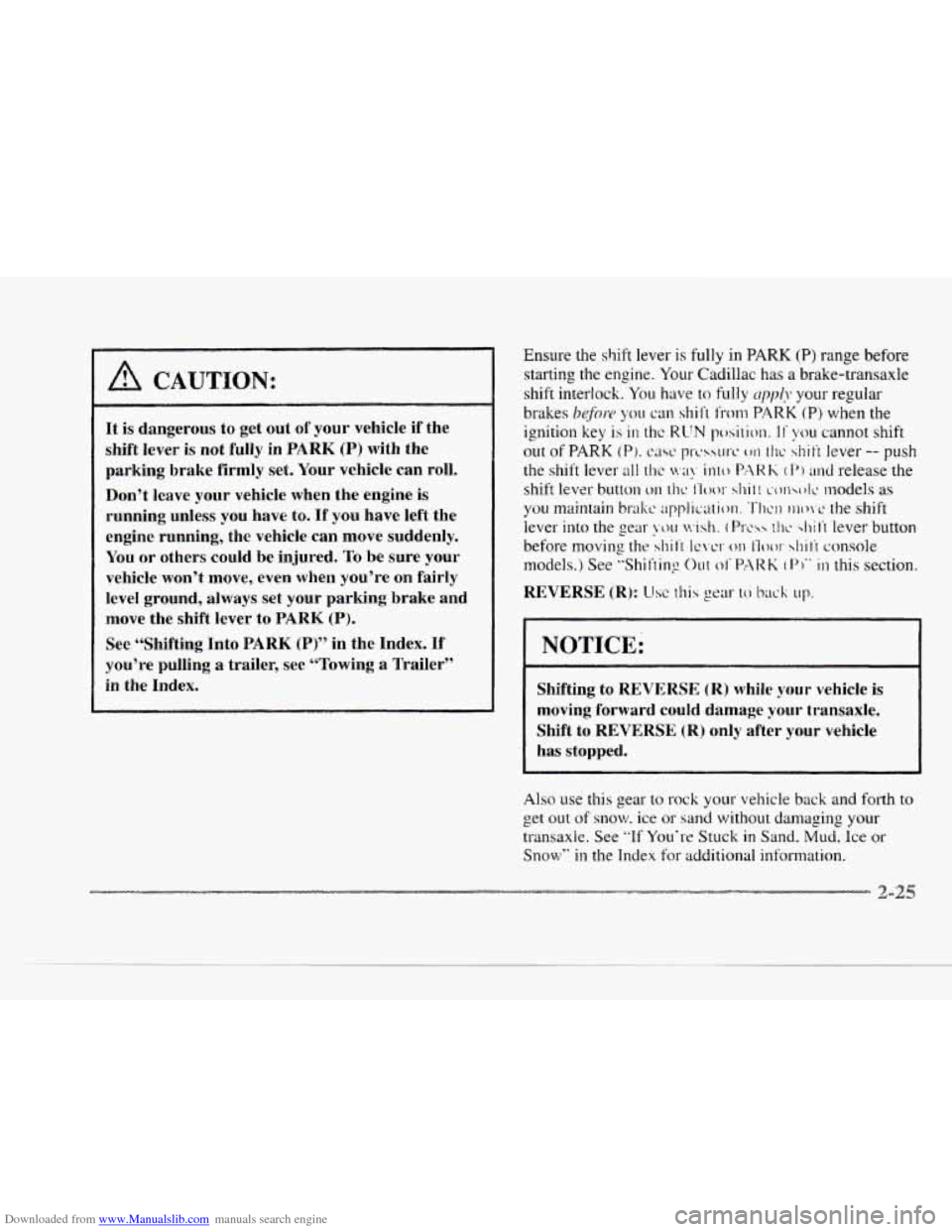
Downloaded from www.Manualslib.com manuals search engine c
CAUTION:
It is dangerous to get out of your vehicle if the
shift lever
is not fully in PARK (P) with the
parking brake firmly set. \’our vehicle can roll.
Don’t leave your vehicle when the engine is
running unless you have to. If
you have left the
engine running,
the vehicle can move suddenly.
I70u or others could be injured. To be sure your
vehicle won’t move, even when you’re
on fairly
level ground, always set your parking brake and
move the shift lever to
PARK (a).
See “Shifting Into PARK (P)” in the Index. If
you9re pulling
a trailer, see “Towing a Trailer”
in the Index. cnsure
the shift lever
is fully in PARK (P) range before
starting the engine. Your Cadillac has
a brake-transaxle
shift interlock.
You have to fully qph your regular
brakes
befory you can shift f’ron? PARK (P) when the
ignition key
is in the RLTN position. I!’you cannot shift
out of PARK (PI. ust‘ pr~~ssurc or] thc shift lever -- push
the shift lever
a11 thc \&+.a!. into PARI< (1’) and release the
shift lever button
on thc: floor shii t cxulhoic models as
you maintain bralit. application. Then IIIO\.C the shift
lever into the gear
~OLI \&:ish. ( p1-c.4~ tflc hi t‘t lever button
before
moving the shit’t le\^^- 011 I’loor shi t‘t console
models.) See ”Shifting Out of‘ PARK PI** in this section.
REVERSE (R): Use t,his pear to iwck 1113.
moving forward could damage your transaxle.
Shift to
REVERSE (R) only after your vehicle
Also use this gear to rock your vehicle back and forth to
get out of snow. ice or sand without damaging your
transaxle. See
“If You‘re Stuck in Sand. Mud, Ice or
Snow” in the Index for additional information.
2-2
Page 87 of 370
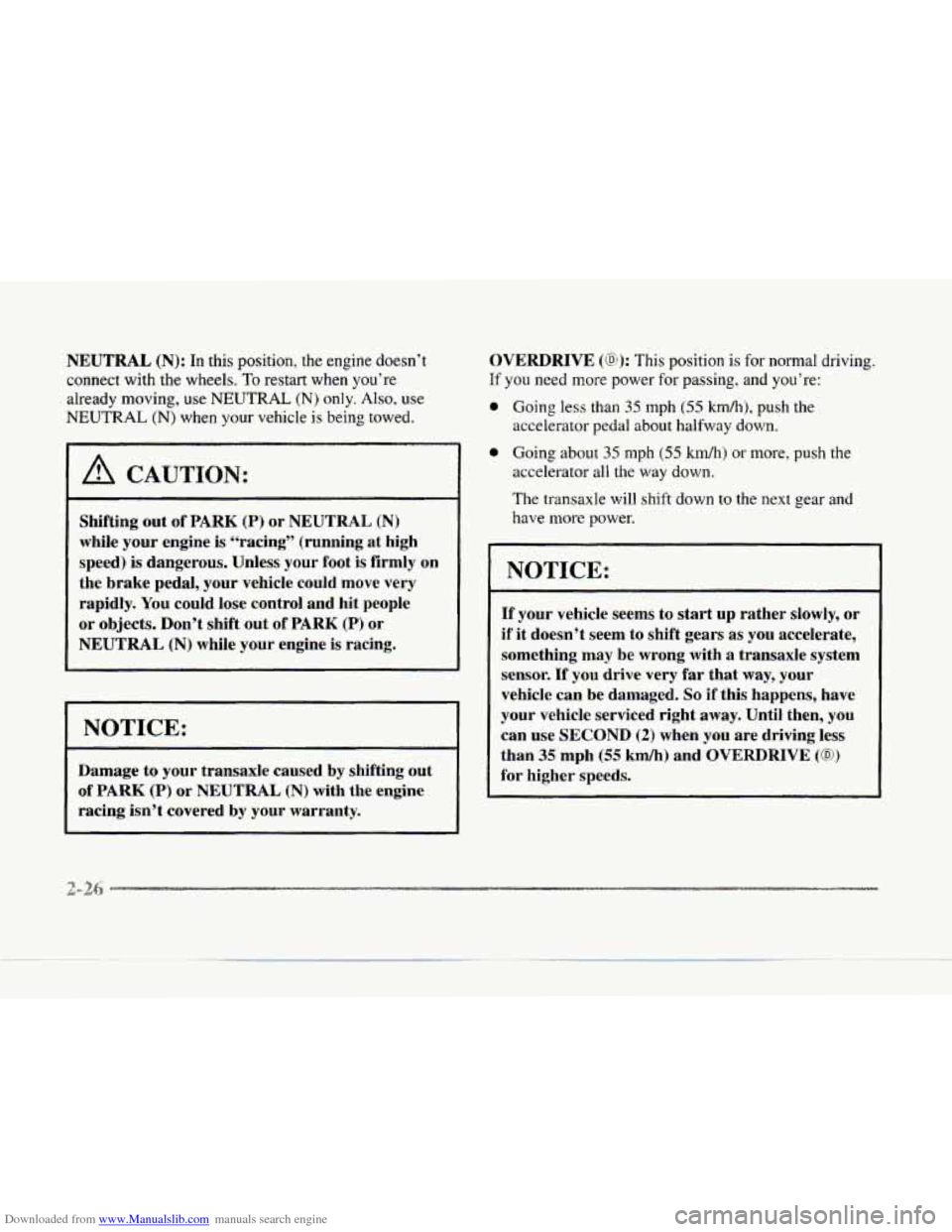
Downloaded from www.Manualslib.com manuals search engine NEUTRAL (N): In this position, the engine doesn’t
connect with the wheels.
To restart when you’re
already moving, use
NEUTRAL (N) only. Also, use
NEUTRAL (N) when your vehicle is being towed.
A CAUTION:
Shifting out of PARK (P) or NEUTRAL (N)
while your engine is “racing” (running at high
speed)
is dangerous. IJnless your foot is firmly on
the brake pedal, your vehicle could move very
rapidly. You could lose control and hit people
or objects. Don’t shift out of
PARK (P) or
NEUTRAL (N) while your engine is racing.
NOTICE:
Damage to your transaxle caused by shifting out
of PARK (P) or NEUTRAL (N) with the engine
racing isn’t covered
by your warranty.
OVERDRIVE (a)): This position is for normal driving.
If you need more power for passing, and you’re:
0 Going less than 35 mph (155 kmh), push the
accelerator pedal about halfway down.
0 Going about 35 mph (55 km/h) or more, push the
accelerator all the way down.
The transaxle will shift down to the next gear and
have more power.
NOTICE:
~~~ ~~ ~-
If your vehicle seems to start up rather slowly, or
if it doesn’t seem to shift gears as you accelerate,
something may be wrong with
a transaxle system
sensor.
If you drive very far that way, your
vehicle can be damaged. So if this happens, have
your vehicle serviced right
away. Until then, you
can use SECOND (2) when you are driving less
than
35 mph (55 km/h) and OVERDRIVE (GO)
for higher speeds.
Page 88 of 370
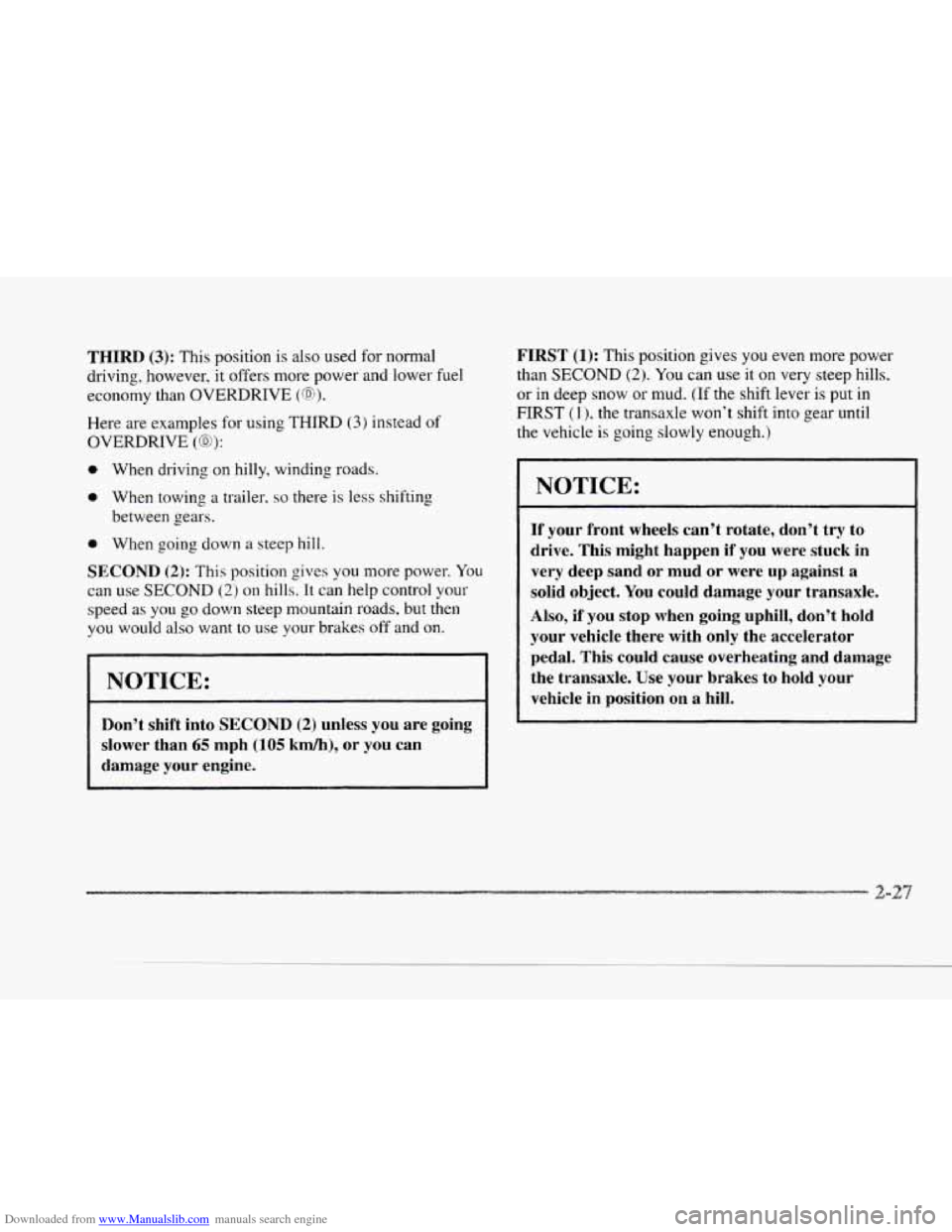
Downloaded from www.Manualslib.com manuals search engine c
c
THIRD (3): This position is also used for normal
driving, however,
it offers more power and lower fuel
economy than OVERDRIVE
(@).
Here are examples for using THIRD (3 j instead of
OVERDRIVE (@) j:
0 When driving on hilly, winding roads.
0 When towing a trailer. so there is less shifting
between gears.
0 When going down a steep hill.
SECOND (2): This position gives you more power. You
can use SECOND (2) on hills. It can help control your
speed
as you go down steep mountain roads, but then
you would also want to use your brakes off and on.
.__
NOTICE:
Don’t shift into SECOND (2) unless you are going
slower than
65 mph (105 km/h), or you can
damage your engine.
FIRST (1): This position gives you even more power
than SECOND
(2). You can use it on very steep hills,
or in deep snow or mud. (If the shift lever is put in
FIRST (1). the transaxle won’t shift into gear until
the vehicle is
going slowly enough.)
NOTICE:
If your front wheels can’t rotate, don’t try to
drive. This might happen
if you were stuck in
very deep sand or mud or were up against a
solid object. You could damage your transaxle.
Also, if you stop when going uphill, don’t hold
your vehicle there with only the accelerator
pedal. This could cause overheating and damage
the transaxle. Use your brakes
to hold your
vehicle
in position on a hill.